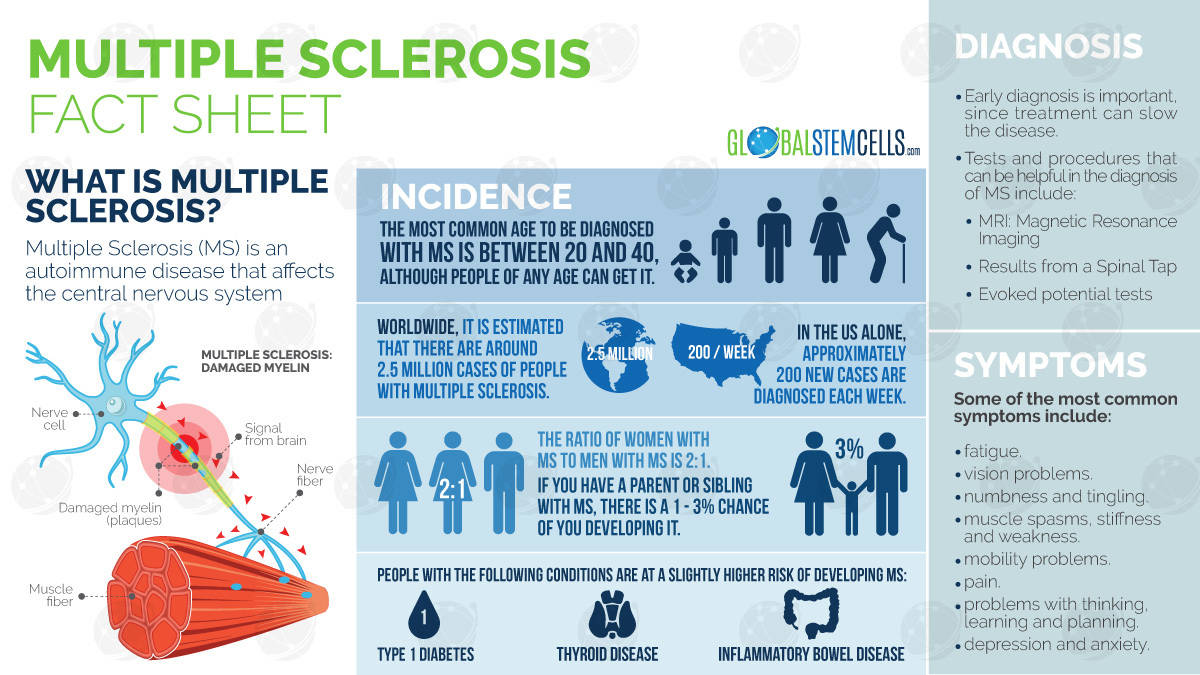Multiple Sclerosis (MS) is an autoimmune disease. Autoimmune diseases (which number more than 80) occur when the body’s own immune system wrongly identifies healthy cells as foreign and ends up attacking them. MS specifically targets cells in the brain and spinal cord for attack.
Multiple Sclerosis comes with a host of debilitating symptoms. These may include partial blindness and other vision-related disorders. Tingling and numbness, stiffness, muscle spasms, fatigue and general weakness are also symptoms that are closely associated with MS. Other indications of the disorder include mobility problems that are accompanied by difficulties in balance and dizziness. Cognitive problems including memory, perception, and learning and problem-solving are further signs that one may be suffering from MS.
Multiple Sclerosis Fact Sheet

MS behaves differently from person to person. Some will have progressive MS where the symptoms progressively worsen. The vast majority, however experience a cyclical manifestation of the disease where symptoms may sometimes completely disappear for lengthy periods (sometimes years) only to return later. The disappearance of the symptoms does not mean that the disease itself has also gone. It is advisable to always seek a medical professional’s advice for clarity on the situation.
Conventional Approach to Treating Multiple Sclerosis
In the absence of an absolute cure the conventional approach to treating MS has been to administer drugs to suppress the immune response. The downside of this approach has been the prohibitively high cost of the drugs and the side effects that they produce.
In Search of a Cure for Multiple Sclerosis
A Cambridge scientist may be on the verge of changing this narrative in her quest for a complete MS cure. This proposed cure hinges on one important question: what controls our body’s immune system preventing it from attacking us? Dr. Su Metcalfe, through her company LIFNano, discovered that the workings of the immune cell are regulated by a small binary switch that is controlled by a stem cell particle known as a LIF.
With this information in hand Dr. Metcalfe began working on a treatment whose main action would be to deliver a LIF into the body using a nanoparticle. The main obstacle in this process was that the LIF would quickly dissolve if it was outside the cell, rendering it ineffective as a treatment. To counter this problem the use of nanoparticles as carriers was proposed. Nanoparticles are made from the same material as surgical stitches which are specifically designed to dissolve in the body. These nanoparticles dissolve slowly inside the body. This allows the LIF that they carry to be gradually released from inside the particle enhancing its effectiveness as a treatment.

LIF keeps the immune cell in check in relation to the human body, but is able to trigger an attack when needed. This stem cell particle also has an alternate twin role in that it keeps both the brain and spinal cord healthy. It also behaves as a natural regenerative medicine by turning on the body’s stem cells and mobilising them in repairing damaged tissue.
LIF also plays a critical role in repairing the brain when it is damaged. This twin characteristic of LIF (reversing autoimmunity and repairing the brain) makes it the ideal ingredient in the continuing search for a definitive cure for Multiple Sclerosis. Clinical trials for this MS therapy are slated to begin in 2020.
Fortunately for MS sufferers, the wait for the much sought-after relief need not be that long. Stem cell therapies have been with us for a number of years now. Multiple Sclerosis is one of the conditions that are successfully managed using stem cell therapies. Stem cell transplantation for MS is particularly effective as it is able to reverse the neurological damage while preventing secondary complications. Stem cells also promote cell growth through differentiation. They also stimulate the stem cells in the brain itself, triggering them to speed up the recovery process.
Through the use of stem cell therapies, combined with supportive therapies and rehabilitation, MS patients have seen remarkable gains in their motor function, balance and coordination. Other areas of marked improvement have been a decrease in neuropathic pain, lessening of fatigue and tremors, improvement in vision and regaining control of one’s bladder and bowel functions.
H/T: Cambridge News




 English
English